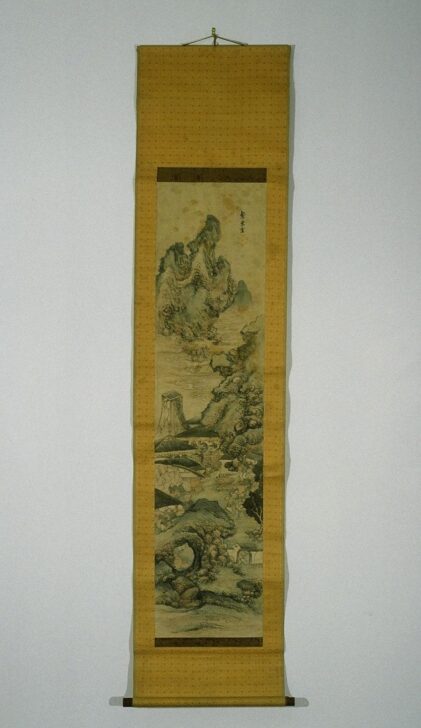Making Pottery by the River
Aoki Mokubei

Description
Subject Matter:
"Born at Kyoto into the Kiya family of restauranteurs, adopting the Aoki surname only after he became a painter (real name Aoki Sahei). He was late-deafened from the noise of his ceramic workshops, and one of his many artist's names, Robei ("deaf [Moku]bei"), comes from this. His ceramic works were intended mainly for the Japanese tea ceremony, and his paintings were chiefly landscapes."
drupaladmin. “Aoki Mokubei.” Gallaudet University Library Guide to Deaf Biographies and Index to Deaf Periodicals, 22 Mar. 2017, 15:59, liblists.wrlc.org/biographies/53928.
"Nanga (southern painting) or Bunjinga (scholar or literati painting) artists took a form of Chinese painting as their model. The Chinese Ming dynasty artist/theorist Dong Qichang (1555–1636) established two categories of painting: northern painting, which was orthodox and academic (painters were formally trained and sold their work for a living); and southern painting, which was freely executed and expressive (ideally these artists were scholar-amateurs who did not paint for a living). Japanese literati artists, although forbidden to travel to China, studied and emulated the southern style of painting and Chinese art theories through imported books. Nanga painters generally declined to serve the samurai class, and preferred instead to survive by selling works to educated merchants and farmers. They often painted for each other and prided themselves as being intellectuals, poets, tea masters, raconteurs, as well as painters. They are most associated with smaller formats, such as hanging scrolls and fans, but several Nanga artists also produced screen paintings. Nanga artists primarily resided in Kyoto and Osaka."
“Japanese Painting: Nanga and Bunjinga School: Education: Asian Art Museum.” Asian Art Museum, education.asianart.org/resources/japanese-painting-nanga-and-bunjinga-school/.
Physical Description:
The hanging scroll depicts a river and mountains. The composition appears to be less three-dimensional with the scenery laying out on the page almost on top of each component. The river snakes through the bottom third of the painting with the mountains and land all throughout. There appear to be roofed buildings towards the bottom of the painting and what seems to be a tall tower-like structure, perhaps a kiln? There is a signature of the artist on the upper right followed by a red seal.
Usage Rights:
If you are interested in using an image for a publication, please visit https://umma.umich.edu/request-image/ for more information and to fill out the online Image Rights and Reproductions Request Form.